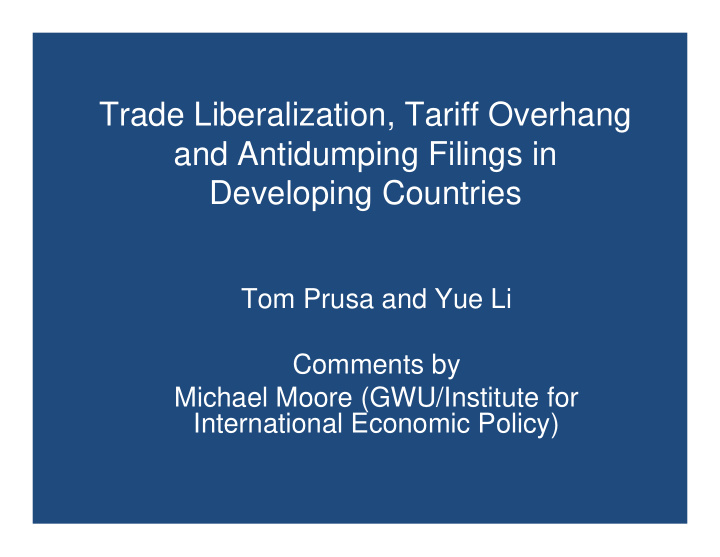



Trade Liberalization, Tariff Overhang and Antidumping Filings in Developing Countries Tom Prusa and Yue Li Comments by Michael Moore (GWU/Institute for International Economic Policy)
• Overarching question: – Alternative to AD as a safety valve for protection – Specifically: reduction in tariff overhang • Developing country focus
• Overarching question: – Alternative to AD as a safety valve for protection – Specifically: reduction in tariff overhang • Developing country focus • Subsidiary question – AD use influence on applied tariffs
• Overarching question: – Alternative to AD as a safety valve for protection • Subsidiary question – AD use influence on applied tariffs (as a safety valve) • Authors’ conclusion – AD has not been used as safety valve – Sufficient tariff overhang exists for use as alternative
Antidumping Link 1 Tariffs • Link 1: Moore and Zanardi (forthcoming CJE) no evidence AD use leads to lower tariffs in developing countries.
Antidumping Link 1 Link 2 Tariffs Tariffs • Link 1: Moore and Zanardi (forthcoming CJE) no evidence AD use leads to lower tariffs in developing cntries.
Antidumping Link 1 Link 2 Tariffs Tariffs • Link 1: Moore and Zanardi (forthcoming CJE) no evidence AD use leads to lower tariffs in developing cntries. • Link 2: Reynolds and Feinberg (2007) lower bound tariffs lead to more AD use Bown and Tovar (2008) lower applied tariffs in India lead to more AD use Moore and Zanardi (2009) Do lower applied rates lead to more AD use in dev. countries?
Antidumping Link 1 Link 2 Alternative: Tariffs Tariffs Reducing tariff overhang • Link 1: Moore and Zanardi (forthcoming CJE) no evidence AD use leads to lower tariffs in developing cntries. • Link 2: Reynolds and Feinberg (2007) lower bound tariffs lead to more AD use Bown and Tovar (2008) lower applied tariffs in India lead to more AD use Moore and Zanardi (2009) Do lower applied rates lead to more AD use in dev. countries?
Concerns • Timing and endogeneity • Initiations vs. orders • Dummy variables vs. number of orders • Omitted variables • Not controlling for industries that may be exporters
Safety valve as smokescreen • Steel industry in the U.S. • Empirical evidence in developing countries • Other reasons for antidumping – Rhetorical – Selective safeguard – Rules based and insulation – Vested interests in bureaucracy and trade bar – No time limit and no compensation necessary
Recommend
More recommend